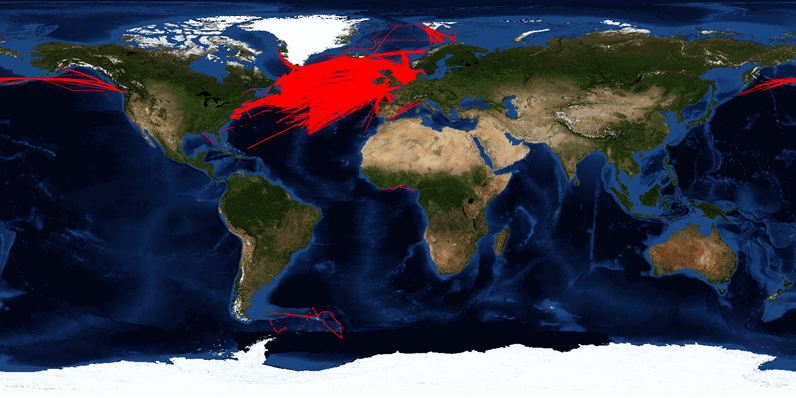Why analyse plankton?

A key aspect of the work undertaken by the CPR Survey is the analysis of plankton samples.
Ranging in size from one hundredth the width of a human hair to several metres in length, the term plankton encompasses a diverse, and often beautiful, world of thousands of different species.
Plankton are sensitive to physical, chemical and biological changes in the environment and can act as the ‘canary in the coal mine’, rapidly responding to a range of environmental stressors. Each species will typically have a preferred set of conditions, thus the accurate identification and enumeration of planktonic taxa is of paramount importance in understanding the health of the oceans.
How do we analyse our samples?
 Samples collected by the Continuous Plankton Recorder are analysed by an expert team of plankton analysts at the Survey, using a standard procedure that has remained unchanged since the 1950s. Crucially, this consistent methodology allows for the direct comparison of samples collected within and between decades and from different geographical regions. In addition to this routine analysis using traditional light microscopy, the Survey has experience of using flow cytometry and has developed molecular methods to help identify planktonic taxa. Since the 1950s, CPR Survey samples have been carefully stored in our International Sample Archive.
Samples collected by the Continuous Plankton Recorder are analysed by an expert team of plankton analysts at the Survey, using a standard procedure that has remained unchanged since the 1950s. Crucially, this consistent methodology allows for the direct comparison of samples collected within and between decades and from different geographical regions. In addition to this routine analysis using traditional light microscopy, the Survey has experience of using flow cytometry and has developed molecular methods to help identify planktonic taxa. Since the 1950s, CPR Survey samples have been carefully stored in our International Sample Archive.
What plankton are analysed? 
The CPR Survey analyses approximately 5500 plankton samples a year. Analysts identify and count both phytoplankton (plant) and zooplankton (animal) taxa, with almost 800 taxonomic entities routinely identified. CPR samples are also assessed for Phytoplankton Colour Index (PCI). With the aid of molecular techniques, planktonic bacteria and viruses, the smallest components of the marine environment, are also analysed.
Where do the samples come from?
The Survey regularly analyses plankton samples from across the North Atlantic, North Pacific and Southern Ocean. The Survey has global expertise, having experience in the identification of plankton from other regions including: around the coast of South Africa, Gulf of Guinea, Indian Ocean, Baltic Sea, Mediterranean Sea and Caribbean Sea.

Excellence
The CPR Survey is committed to delivering excellence. Throughout the entire analysis process, rigorous internal quality control and quality assurance procedures are adhered to. Analyst’s phytoplankton identification skills are regularly assessed by the International Phytoplankton Intercomparision (IPI) partnership. In collaboration with the NE Atlantic Marine Biological Analytical Quality Control (NMBAQC) Scheme, the CPR Survey is actively leading the ongoing development of an external quality control component for zooplankton.
Services the CPR Survey can offer
As well as analysis of CPR samples, the Survey is also able to offer diverse consultancy services using plankton analysis of samples collected using other methods.
Considered an International Centre of Excellence for planktonic taxa identification and with experience in plankton analysis from around the globe, the Survey regularly trains scientists from around the world in plankton identification skills and offers a series of training opportunities.

